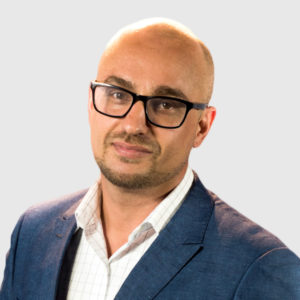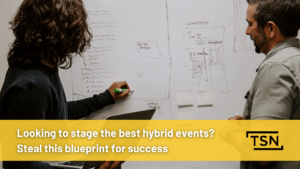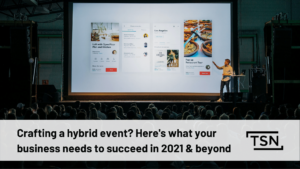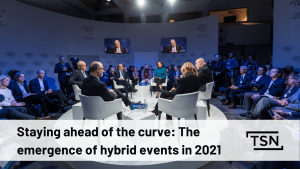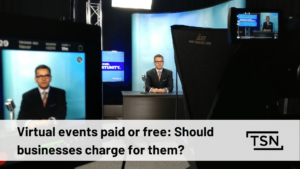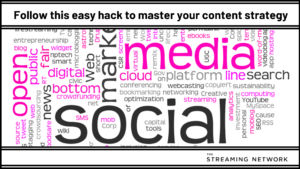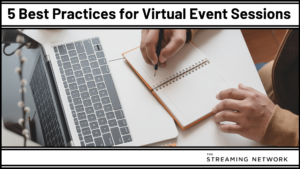Podcast: Play in new window | Download | Embed
Subscribe: Apple Podcasts | Google Podcasts | RSS
Lessons From The Frontline
In our last episode, we discussed some of the challenges faced by legal marketers. Specifically, the lack of utilizing deep data integration and its effect on their webinar programs. We also dove into what a strong webinar looked like; establishing oneself as a Thought Leader in their respective field.
In our tenth episode, we are discussing:
- Taking Your Webinar To The Next Level: Why it is important to record your webinar in a studio, and not in your boardroom?
- What You Should Think About Before Coming To The Studio: How should you prepare for studio production?
- Common Mistakes When Planning A Webinar: Why it doesn’t matter if you are the most charismatic expert in your field.
The Complete Video Transcript
Pete: Webinars are hot. As a content marketing professional, I’ve produced hundreds of videos for social and traditional media platforms and currently work with one of the largest broadcast networks in the country.
So, for me, understanding how webinars work in the B2B space is both essential to my professional development and an exciting form of content creation. According to a study commissioned by digital agency DemandWave, 41% of B2B marketers cite webinars as the best marketing tactic for driving revenue.
I’ve set out to discuss webinars with one of the foremost experts in the field, Matt Ley, President of The Streaming Network in Toronto. Together, we’ve created this multipart series of videos and podcasts; The Webinar, Lessons from the Frontline, or How I Learned to Live with Never Getting a Second Chance with Live Virtual Events.
Welcome back to the webinar, Lessons from the Frontline. Today we’re talking about creating content in a studio. When does it make sense? With me as usual is Matthew Ley, President of The Streaming Network. So, we’ve in a studio.
Matthew Ley: Yeah.
Pete: This is not my basement. Those that think that this is my basement, and I know there–many of our audience do, this is in fact–as you’ll see, this is not a brick wall. This is a studio. We are here in a studio.
So, The Streaming Network created a studio, built–.
Matt Ley: –Yeah–.
Pete: –A studio. Talk to me about the history of this, of the studio and how this all came about.
Matt Ley: Well, it came out of basically a necessity. But we’ve always been one of the bigger video webcasting companies or webinar companies out there. We’ve built our brand and our name on it. And as it became easier to produce video out there, our customers wanted to do more and more complex things.
And so, we got onboard. We loved the idea of turning a video webinar into a show. We got into doing things like you see up here with, like, a set that resembles, like, a news set or whatever it might be.
Pete: I want that set. Why can’t I have that set?
Matt Ley: ‘Cause that set is for when–we got to trick people, right? So, this is the podcast.
Pete: Oh.
Matt Ley: When I do webinars, that’s my set.
Pete: All right. Like, the next time, you’re going to see us on this set.
Matt Ley: Yeah.
Pete: This is going to be our set.
Matt Ley: We can–we definitely can use it, just need to set it up.
But when you’re going in to do that at–where we would conventionally be doing a webinar, whether it be in someone’s office or it would be at a venue or whatever it might be, there’s a lot of setup that goes into that, which was labor intensive for us, and a lot of things can go wrong when you’re setting everything up from scratch. So, to really do it well, we needed to go into a studio.
And initially we rented studios, and we found that in Toronto there wasn’t a lot of options. There were studios that were made for television, which were awesome but expensive, generally union, not aligned with budgets of your average corporate customer. And then there were big empty spaces that were used, usually for photography and a little bit of shooting to tape, but not sort of live development.
Pete: Right.
Matthew Ley: So, with nothing being really available in our market, and I’m sure those who are listening or watching this from outside of our market, they realize there’s not available in most places–.
Pete: –Yeah–.
Matthew Ley: –We thought that it would be a good investment to start building out a studio like this so that we could initially do our live events from it in a controlled environment that we knew just worked.
Pete: Right. And a lot of people I think use–they won’t even use a studio. They’ll use a warehouse space.
Matthew Ley: Yeah.
Pete: And there’s inherent problems with that. There’s fans and people–.
Matthew Ley: –Oh, there’s so many–.
Pete: –There’s chairs–.
Matthew Ley: –Yeah, so many things–.
Pete: –Scratching and all kind–.
Matthew Ley: –Yeah–.
Pete: –Streetcars, you know, passing by, things like that.
Matthew Ley: Yeah.
Pete: So, let’s talk about what type of content is best delivered in a studio environment. What do–if you’re giving somebody advice and they come to you and they say we want to do this or that–.
Matthew Ley: –Yeah–.
Pete: –What’s your take on that?
Matthew Ley: Yeah. I think I would think about, you know, in this day and age, where are the things that we watch shot, right? So, a news program, an interview, something like this is done in a studio. It’s not done in someone’s boardroom–.
Pete: –Right–.
Matthew Ley: –Right? And even the production value of, I mean, 20/20 is really high, but there’s a difference when they’re going out and they’re in someone’s living room than when they’re in a studio kind of doing it.
So, if you’re doing something that is, you know, thought leadership-based, something like what we’re doing today, interview, you’re looking to shoot a bunch of content that way, the studio is right for you.
Pete: Right.
Matthew Ley: Back in the day when they were making film–initially making films, they did everything in studios, right? They would have fake sets that looked like, you know, the Sahara Desert or they would have a fake set that looked like a castle. And when you go back and you watch it, it looks just like that.
Pete: Yeah.
Matthew Ley: Same thing happens here in the studio even with the technology and green screen and all of that. It–you know, when you’re doing something and you’re trying to make it look like it’s something else, it’s going to fail. There’s a reason to shoot on a–at–on location.
Pete: Right.
Matthew Ley: And it’s–there’s a great analogy that our director of live events, Bryan Squire, made once, which is, you know, I would never go to your factory or your boardroom to shoot a video, just like you should never come to my studio to have a meeting, is that things are made for certain things–.
Pete: –Right–.
Matthew Ley: –Right? And so, there’s times when we will say it would be great if we could do it there.
But most of the time for the kind of stuff that we’re doing and the kind of stuff we do for our customers, which is usually marketing, thought leadership, training and education, this place makes sense.
Pete: Right. Excellent.
Now, you mentioned thought leadership.
Matthew Ley: Yeah.
Pete: So–and that’s a lot of what happens in the studio is–.
Matthew Ley: –Um-hmm–.
Pete: –Sort of thought leadership-based types of productions.
Matthew Ley: Yeah.
Pete: So, let’s talk a little bit about that, the type of work that is done here.
Matthew Ley: Yeah. And, I mean, it is that. In this day and age, people need to produce more video content. It’s the most consumed type of content on the Internet. Everyone wants to do it.
They have a need to produce different lengths of video for different buyers. They have the need to constantly be coming out with new content. And so, the idea of producing video for thought leadership is growing and is expanding. And because–I think it’s because a lot of our customers are marketers who are using our webinar platform and they initially learn about the studios. They can come in and take their webinar to the next level and do some sort of a panel discussion or something like that in studio. Then they say, hey, we could use this for something else.
Pete: Um-hmm.
Matthew Ley: And so, that’s predominantly what’s being done here.
The other thing that we see done a lot is the–is role play training videos, internal stuff where you could record it at your office. That might make sense ’cause you say you have access to people, but those people also have other meetings they got to run to, emails. You get them here. They’re locked in a room. They schedule a day, and it’s always way more productive than being done at your office.
Pete: Right.
When somebody comes walking, you know, into the studio–.
Matthew Ley: –Yeah–.
Pete: –They obviously need to come in with a certain prepared–a certain mindset.
Matthew Ley: Yeah.
Pete: They–what should people be thinking about before they even come to the studio?
Matthew Ley: Yeah. Well, like anything, you want to be–you want to think about what is the outcome, right, and what are you trying to accomplish. And that sounds simple and silly sometimes just to bring it up, but it is important.
You don’t know what’s going to happen when you get in here, right? Maybe the speaker or the panelist or whomever’s on it, they’re having a rough day or an off day. Maybe you’ve budgeted too much time for someone. But you need to ensure that you know exactly what you have to get out of the day.
So, you have your primary things you need to get out of the day, and then you can start looking at sort of the secondary elements that you need to get done. So, that’s something that people do need to think about.
They also need to take a real hard look at the people that they’re bringing in here. And that is to understand their strengths, their comfort levels, their–you know, are they long-winded like me? Are they someone who needs to open up a little bit more? Do they work better off script or on script? If you’re going to do a teleprompter, have they ever even used a teleprompter before? Because I assure you that’s one good way to make a charismatic speaker look very robotic is put a teleprompter in front of them and ask them to start reading.
Pete: Yeah.
Matthew Ley: You know, Barack Obama did not come out of the womb being able to read off a prompter the way he did.
Pete: Yeah.
Matthew Ley: That is an acquired skill.
Pete: Yeah.
Matthew Ley: That cannot be understated.
Pete: And Donald Trump still hasn’t figured it out.
Matthew Ley: No, he really, really–I don’t think he wants to be told anything.
Pete: No. No.
Matthew Ley: So, you really got–you got to really think about it. The studio provides this answer for you; controlled environment, good sound and lighting, sets and options to make your video look professional. But it doesn’t mean that everyone is going to come in and come across professional. And you got to think about all the various things that will–that you will do with your people to make sure that that works out.
Pete: Right.
Let’s dig into that a little bit more.
Matthew Ley: Yeah.
Pete: In terms of–you know, you’ve seen all kinds of things.
Matthew Ley: Yeah.
Pete: Common mistakes people make in the planning stages, you know–.
Matthew Ley: –Yeah–.
Pete: –In terms of, you know–and I know we’ve talked about this, but just because somebody’s comfortable speaking publicly–.
Matthew Ley: –Yeah–.
Pete: –Does not necessarily mean that they’re going to be comfortable speaking when the cameras go on in–.
Matthew Ley: –Yeah–.
Pete: –These sorts of situations.
Matthew Ley: Yeah. I mean, yeah, I hear that a lot. Oh, you should see them. They just gave a speech at this conference. There was a–there was 10,000 people there, and it was–and they were awesome.
Well, yeah, they’re feeding off that 10,000 people. It’s totally different than when they’re staring down a camera. Or, you know, he’s on–he or she’s on BNN all the time, or they’re on this thing and everything’s great. Well, on those shows what happens? You’re being interviewed by–.
Pete: –Um-hmm–.
Matthew Ley: –Someone like yourself, right? You’re not, again, just sort of talking to a camera or delivering.
And so, that’s a mistake that people make is overestimating their talent. We are not working with professionals. We are working with lawyers, software developers, you know, doctors. They are not professional on-camera talent, actors or the like. So, that’s one big mistake that people make.
The other mistake I think that people often make is over-scripting everybody. There’s certain types of videos where you need to say only, like, you know, types of words. Short commercials, everything is scripted, and I totally understand that. But in the realm of thought leadership where you’re trying–generally when people come in, they want to get a lot of stuff done–over-scripting can just get people to freeze up.
You have to take multiple takes to get the same thing out of it. And although I assure you that if you’re doing it right in studio you leave exhausted, you can’t get wrapped up in that level of minutia with this type of a video production. And when you do, you’re almost never happy with the outcome. So, those would the common mistakes that I–.
Pete: –Okay–.
Matthew Ley: –Most often see.
Pete: Right.
So, when people get into the studio, they’ve done the preparation they need–.
Matthew Ley: –Yeah–.
Pete: –To, but they–once they get in here, what should they be focusing on? What’s the sort of few things that you think–?
Matthew Ley: –Yeah–.
Pete: –Are key?
Matthew Ley: Well, you want to be focusing on how comfortable the speaker is or the people that you’ve got on camera. You want to make sure they’re comfortable. And that can start with just making sure that–I always say to people when they ask me what should I wear, outside of certain things like, you know, never wear green when you’re on green screen or certain other aspects of attire that don’t work, it’s wear what you normally wear.
If–you know, this, I’m lucky. My office is upstairs. We worked a full day. We walked down. We jumped in the studio. This is what we wore to the office today.
Pete: Um-hmm.
Matthew Ley: We’re both comfortable in this attire. There’s nothing unique about it.
But, you know, one guest said to me I wear a hoodie everywhere I go. He has a software or SaaS product. He’s like what should I–can I wear the hoodie on camera? I’m–exactly what you should wear–.
Pete: –Um-hmm–.
Matthew Ley: –‘Cause this is you coming forward.
Pete: Right.
Matthew Ley: Be comfortable if you’re going to be comfortable.
And then the other thing is that, you know, as–is that everyone around should do everything they can to make the talent comfortable. This is what happens when you go on a late night program. You go into a green room and they make sure you’ve got your Smarties or your M&M’S that you want. They make sure that you get greeted by someone and you’re shown. That’s so that you’re comfortable when you get on camera.
Pete: Right.
Matthew Ley: And–.
Pete: –A glass of whiskey.
Matthew Ley: A glass of whiskey makes–.
Pete: –Whatever you need–.
Matthew Ley: –It easier. Right. Yeah. We don’t actually have booze here, but maybe that’s something we should look into.
Pete: Yeah.
Matthew Ley: And a lot of times format does this, okay? So, almost every example you’ll see on our YouTube page or if you look at our various set options, of which we have a number of them, it always resembles some sort of a news broadcast, talk show, chat show, whatever it might be.
And this was born out of the idea that we–when this industry started, when I started in this industry over 10 years ago, it started with every speaker looking at a camera. A lot of it was because we had one camera ’cause cameras were really expensive, and this whole thing has gotten a lot more cost effective, but it was everyone was looking straight at a camera.
Now, before they looked at the camera, we had them talking to one another, whether it be the–you know, the marketer and the thought leader or the CEO and their person. And the things that were coming out of their mouth were passionate. They were interesting. They flowed with very few ums and ahs. And then they looked at the camera and they were–.
Pete: –Stiff–.
Matthew Ley: –Froze up. They were staring down this weird black eye. They knew in many cases they could retake. And it just spiraled sometimes, you know?
And we thought, hey, what if we could capture what happened before, that very casual based conversation? And so, to do that, we started saying, well, let’s emulate what we see in the media. Let’s do the financial show, not the financial webcast. And in our model and in the model that we’ve deployed, which you’ll see almost everywhere, the person in your seat is the most important person.
It’s not me, the guy who has the ideas. It’s you being able to guide us through this and make sure that we’re on topic and I feel good, and if I freeze up, you can help me out or–.
Pete: –Right–.
Matthew Ley: –Drive me to the right spot.
So, that host, that two person in–on set, we find makes people way more comfortable than they could ever be standing there alone.
Pete: Right. And they recognize it too, because ultimately you watch the late show. You watch the evening news–.
Matthew Ley: –Yeah–.
Pete: –It’s–you’re–you would instantly be comfortable with it because you instantly recognize that as opposed to who the–whoever stands just looking at a camera?
Matthew Ley: Exactly. And yet–that’s right, and–I mean, and people kind of get this idea. You’re going to be asking me questions. I’m the smart guy or whatever ’cause I’m–.
Pete: –Yeah–.
Matthew Ley: –The one answering them. We are disseminating information not unlike that other model–.
Pete: –Yeah–.
Matthew Ley: –Podcast, news broadcast, Oprah Winfrey Show, whatever–.
Pete: –Yeah–.
Matthew Ley: –Show meets your–the persona of what you’re trying to accomplish.
Pete: Yeah.
Matthew Ley: People, when they look at it, they know exactly what’s going to happen next–.
Pete: –Yeah–.
Matthew Ley: –Which is good.
Pete: Yeah.
Matthew Ley: We like that.
Pete: They already have–they’re comfortable with it. They already understand the–.
Matthew Ley: –Yes–.
Pete: –Parameters.
How do things go off the rails? So, you’re in a studio–.
Matthew Ley: –Yeah–.
Pete: –And all of a sudden–and I’m sure you’ve seen it. I’m–I’ve experienced it. What happens?
Matthew Ley: Yeah. Well, so many things can happen, but let’s just assume that we’ve got it all planned, right? Like, we–we’ve got the show format. We’ve got the M&M’S in the lobby there. That person’s wearing their hoodie and they’re comfortable. We didn’t over-script things. Then the normal things that happen every day that can go off the rails, and that is the world still happens outside of these doors.
Pete: Um-hmm.
Matthew Ley: Since everyone who generally comes in here to talk, most people cannot turn it off for that long, we are doing corporate stuff here, is that they get pulled away. They have to take a call. They’ve got–a bad email just came in. They just lost an account and now they’ve got to perform or, heaven forbid, your time with them gets cut short.
And so, often, if you’re not just doing a live event for one hour where everyone locks themselves in, you’re trying to do a whole day, you’ve got to be able to kind of roll with the punches and be able to do that.
The next thing that I see that really gets things off the rails is getting into retake kind of hell, the idea that they know that they can retake something and so they do, and now everyone starts. I don’t know why it happens. The talent starts saying we should retake that. The host starts saying we should retake that. The person in the other room watching it says we should start–we should retake that one. And you’re not focusing on the time or those initial goals and outcomes that you had and you’re focused on getting this thing perfect.
Pete: Um-hmm.
Matthew Ley: Look, we’re pretty good. We’ve been doing this now, this is like–I don’t know, however many podcasts.
Pete: Ten.
Matthew Ley: Ten.
Pete: Ten.
Matthew Ley: This is our tenth time working together on this. We’re not perfect today. We’re not going to be perfect a hundred in. We’re not, and we go back and we got jobs that we got to do. Your people are never going to be perfect. Don’t try and make them perfect.
Pete: Yeah.
Matthew Ley: We are fallible. We are human. It makes sense that when we’re on here we’re not absolutely perfect. And that can really derail a day.
Pete: And I think that from–in my experience as well, what–the relaxed sort of state go–every new take–.
Matthew Ley: –Yeah–.
Pete: –You lose that sort of more organic kind of–.
Matthew Ley: –Oh, definitely–.
Pete: –Way of–approach these things. And you’ll never get it as good–.
Matthew Ley: –Yeah–.
Pete: –As when the person’s just saying it for the first time.
Matthew Ley: Yeah.
Pete: Yeah.
Matthew Ley: And let’s think about–we talk about thought leadership–what is thought leadership in the marketing? And this type of stuff that we’re doing here, it’s to get people to come in and to talk to us about buying our products or knowing about our brand and all of that stuff.
And so, how likeable and how engaging this all is is as important as the content that we are delivering, because if someone tunes out or someone–and we’re not memorable or anything like that, it’s not going to get them to that next stage–.
Pete: –Yeah–.
Matthew Ley: –Right, and engage with the organization or engage with the brand in general.
Pete: Yeah. Yeah. Oh, for sure.
So, what are some tips for getting the most out of the studio? What would you–what are you telling people?
Matthew Ley: Yeah. So, one tip that we have is to bring–do a content-based day. So, what I mean by that is you can get a lot done in eight hours. It’s not an eight hour day. You got lunch. You got all kinds of stuff, but you can get a lot done.
So, if you’re going to come in, think about how to do, you know, eight hours on a certain thing, not just achieve that one video you want to get to, not shoot three drastically different things in the course of a day, but focus on, you know, all the–all content around a subject.
So, an example of this might be, you know, we have a package now that we’re doing after our CEO did it which was a one day, gets you 12 vlogs for the year. Come in and that’s all you’re doing that day. I shouldn’t say all, because that becomes, you know, one video blog every month. That’s your–sort of your strategy.
We have another one that’s based around getting six long format podcasts like this done in a day. And that’s a grueling day, but it also gets video for social and it’s all around one topic base, right? And so, when you focus on that one topic, everyone’s in the same mindset. It’s real easy to do, you know, those short format clips that you need to get that executive buyer to watch. It’s easy to rephrase a longwinded response like I’m giving right now into something that will work in a–.
Pete: –Um-hmm–.
Matthew Ley: –One to two minute video. And everyone’s head’s in the same spot. They’re not bounding around.
So, whether it be one topic or one person–if you got three thought leaders, you might think, well, I’ll do one for two hours, one for two hours, one for two hours. I know why. It’s cheaper. But if you’re trying to do that or you’re trying to bring in three executives or whatever it is, focus around them.
They probably need lots of content anyways. And if you focus with them, it becomes their day to accomplish everything that they want. And so, I guess narrowing the scope and expanding the amount of content that you can get out of it is one way to get the most out of the studio.
Pete: Excellent. Okay.
So, once you’re finished and you’ve done the production, what’s sort of the next things that happen in the–you know, the continuum of–?
Matthew Ley: –The black–.
Pete: –Production?
Matthew Ley: Yeah, the black hole of post-production–.
Pete: –Yeah–.
Matthew Ley: –Right?
My favorite stories was I was–it wasn’t a studio shoot, but it was early days. And we had shot a–it was a–I–the drip bag. You know when you’re in hospital, what is the–IV.
Pete: IV, yeah.
Matthew Ley: It was an IV drip bag.
Pete: Yep.
Matthew Ley: And the–we had to–we actually got access to a doctor’s office on a–or a clinic on a weekend, which we never get. And we’re in there and we’re shooting in a clinic, which was great. And it was all about this new IV bag that was coming out.
And so, then we get the footage. We edit it together and, like, great. Well, here’s a picture of the new IV bag. That was the old one. You can just post-production that in, right? And I remember when I got it going, “What is this guy talking about?” Like, I mean, at that point in time, you know, Lucas Film couldn’t post-produce–put that in there.
And so, you know, their–I say that as an unrealistic expectation of what can happen in post-production. But post-production can become hell for these things, right? You come in ’cause you want to get content. You know what you want them to say. They say it three or four times. You want to look at all of the footage and then you want to decide what you’re going to use for your various things.
And when we give you that footage and you’ve got three to four hours of Pete and Matt talking about webinars with time code burnt in and you got to decide what the cuts are that are needed, you go into what’s called post-production hell.
Pete: Right.
Matthew Ley: And so–.
Pete: –‘Cause it’s all so great.
Matthew Ley: Oh, it’s all so great within–yeah. Yeah, all so great.
Pete: What can we cut out of this great–?
Matthew Ley: –What could we cut out of this, right? It’s–.
Pete: –To turn it into a 20 minute–.
Matthew Ley: –Amazing.
Pete: Right, right.
Matthew Ley: It’s amazing.
So, what should happen is that, with the proper preplanning and with an engaged team in the studio, is that everyone should pretty much know what are the golden takes, what are the pieces that they want.
Pete: Um-hmm.
Matthew Ley: If you want to use something like this like we do, that is, you know, 20, 30 minutes and then we have our five minutes and our 30 second spots, well, you script it that way. You work it that way. You keep that in mind while you are shooting. If there are graphics packages or there’s other elements you want to put on that, work on that beforehand in tandem so you’re not going through that after.
So, what really should happen is you should leave the studio and within 24 hours you should get a look-see edit–.
Pete: –Right–.
Matthew Ley: –Something that just lets you, you know, see how things went or whatever. Maybe you’ve got other footage that you want to look at. And then you should get into small tweaks on what it is that you want. And from that point on, I mean, you should really be looking at getting finished product quite quickly.
And after that, what you should do is you should be talking to the team that you worked with, whether it be the speakers, whether it be us as a partner or whoever it was, your producer, to talk about what went right and what went wrong–.
Pete: –Right–.
Matthew Ley: –So that you can get better at doing this. We are good at doing–and every studio, not just us. Everyone is good at getting you in the door, that stuff I talked about, making you feel comfortable shooting, making sure that we sound and look good. But not knowing your company or the person, the personality of the people that are coming in means that there’s a lot that you need to learn as you start getting into being the person responsible for the video at your organization.
Pete: Great. Excellent.
Let’s talk about today.
Matthew Ley: Yeah.
Pete: Let’s talk about what we’re doing here.
Matthew Ley: Yeah.
Pete: We are here in a studio, so let’s–.
Matthew Ley: –We are–.
Pete: –Break this down for our audience.
Matthew Ley: Yeah. So, I mean, well, all this started with you. I think we’ve told the story. I don’t know if it was on here. We started with you pitching me many moons ago on podcasting. And I said why would I want to do podcasting, ’cause I’ve got a studio. I’ve got webinars or whatever. And then you talked me through the importance of that.
And we went and did our first series. And that first series was six webinars in one day. It was–.
Pete: –Um-hmm–.
Matthew Ley: –A bit of a tiring day of getting to know each other sort of thing.
Pete: Yeah.
Matthew Ley: And that turned into–with, you know, the work that you did, the post-production, and then our marketing team, that turned into all the content we needed for three months.
Pete: Right.
Matthew Ley: And leading up to that, we were a little bit like the plumber with the leaky pipe, is that I had the studio downstairs and I had all the stuff, but we were doing, you know, one or two big webinars every quarter and that was it.
Pete: Yeah.
Matthew Ley: We were not doing a lot of it.
And so, basically what we are doing today is a continuation of what started that day. And it’s our–I’m not going to say it’s our entire content strategy, but it’s pretty much based around this.
Pete: Yeah.
Matthew Ley: You and me go in. We figure out what we’re going to talk about. We talk. It gets chopped up in many different ways. There’s other people who write it and get it turned into blogs. There’s people that are going to take it and turn it into e-books. And it’s basically done as the start of anything that we’re going to be doing–.
Pete: –Right–.
Matthew Ley: –As an organization.
So, this is a short one, right? We’re doing two today. Usually we do–.
Pete: –Um-hmm–.
Matthew Ley: –A lot more, and that’s because of a call we had with our agency–.
Pete: –Yeah–.
Matthew Ley: –When they said, you know, when can you get these done. And we’re like, well, I guess we can get them done this week.
Pete: Right.
Matthew Ley: And then we came in to do them because they’ve got plans and ads and all kinds of things that are planned based around what it is that we’re getting done here today.
Pete: It also speaks to the fact–we did six in the first day, but–and you’ve talked about this, but it’s the first–.
Matthew Ley: –Yeah–.
Pete: –Album, right? We had no problem coming up with six for the first day. As this goes on–.
Matthew Ley: –Yes–.
Pete: –Coming up with new subjects and not recycling and–you know, it’s–.
Matthew Ley: –Yeah–.
Pete: –It starts to get–you know, you have to get creative.
Matthew Ley: Yeah.
Pete: You know, you have to come up with whole new angles and whole new–.
Matthew Ley: –The sophomore album and that sophomore jinx is there for a reason.
Pete: Yeah.
Matthew Ley: You know, I’ve been saying the same stuff about–.
Pete: –Yeah–.
Matthew Ley: –Webinars and webcasts for a bunch of years.
Pete: Yeah.
Matthew Ley: And for most audience members who are hearing from me the first time when I walk into a boardroom or when I’m asked to speak at a conference, that stuff’s gold, right? It’s the stuff that I’ve learned over 10 years of doing this.
Pete: Yeah.
Matthew Ley: I add–I’ve got new stories and new iterations, but it’s the same basic point. But when you do something like this and you got people coming–.
Pete: –Yeah–.
Matthew Ley: –Back, right–.
Pete: –Yeah–.
Matthew Ley: –And listening, you’re right. It’s hard to keep that–keep it relevant.
What I think we’ve done and what inevitably happens as these things grow on is you start out here, all things webinar, and then you get down–and we’re about here. I don’t think we’re here yet.
Pete: Yeah.
Matthew Ley: But we go down and we did verticals earlier this year. What does it mean for financial services? Now we’re doing specifically things like just studio, not video but just studio, when to use the studio.
Pete: Yeah.
Matthew Ley: You start getting more and more focused. And the more focused we get, I’m hoping the more value that we’re giving our audience–.
Pete: –Yeah–.
Matthew Ley: –Too.
Pete: And we’re also using data, right?
Matthew Ley: Yes.
Pete: Now we–we’re starting to understand that there is a reason to do something about the studio because we’ve put stuff–.
Matthew Ley: –Yeah–.
Pete: –Out there. People are–you know, are–they’re actually reacting–.
Matthew Ley: –Yeah–.
Pete: –To our–so, it’s like, well, of course we should do a podcast on the studio, because there’s other things we’re doing around the studio, and it’s driving interest.
Matthew Ley: Exactly. And–.
Pete: –Right? So, we’re using the data to actually–.
Matthew Ley: –Yeah–.
Pete: –Now that we’ve started it, we’re using the data to inform us and keep–.
Matthew Ley: –And that’s the thing–.
Pete: –People going–.
Matthew Ley: –About that too is that–’cause we’ve been on the other side too where, you know, you’re working on agency, like, projects or, like, commercials and that sort of thing. And the nice thing about this idea, the star point for all of that, is what comes out of it today is you get all of the stuff about the studio that’s going to be turned into really great stuff, but we can do this really quickly.
Pete: Um-hmm.
Matthew Ley: So, if you buy into this idea about video for thought leadership in this sort of format, it allows you to be quickly reactive, right? We started getting a–to your point, data. We started getting a bunch of social ads working–.
Pete: –Yeah–.
Matthew Ley: –For the studio. And we have people coming through here all the time trying to–looking to rent it and use our team. And so, everyone who is measuring those ads says we need to have something that does this or does this. And so, we’re able to come in here and easily do this without a lot of work–.
Pete: –Yeah–.
Matthew Ley: –Which our customers can do as well for whatever it is that is going on.
Think about if we were then to go and work with those same people who asked us to do this to do a 90-second spot on the studio. We’ve talking about that for two months–.
Pete: –Yeah–.
Matthew Ley: –And it still–we don’t even have the final draft yet, right?
Pete: Yeah.
Matthew Ley: We’re still reworking that.
Pete: Yeah.
Matthew Ley: So–.
Pete: –Yeah–.
Matthew Ley: –There’s a lot. It’s very interesting how everything we’re doing now when we’re pitching it is just basically what you and me have learned doing it–.
Pete: –Yeah. Yeah–.
Matthew Ley: –Which is really neat.
Pete: Yeah, it is. And you could actually do the 90-second spot now–.
Matthew Ley: –Yes–.
Pete: –Right?
Matthew Ley: Yeah, we could. Yeah, we could.
Pete: Go ahead.
Matthew Ley: Yeah, I was going to say we cut and then maybe we’ll pretend like I just did it right there on the spot.
Pete: We’ll do it, right. Just hold on a second.
Matthew Ley: It was literally on the spot, yeah.
Pete: All right.
Listen, this has been, as usual, very, very informative, and I’ve really enjoyed this. And this is, you know, a–my favorite thing is the studio and–.
Matthew Ley: –Yeah–.
Pete: –Part of what I pursue here. So, this is–it’s, as usual, just a great–another great podcast.
Matthew Ley: Thanks, Pete.
Pete: And we’ll see you next time.
Matthew Ley: For sure.
Pete: All right. Ninety second pitch, take 11.
Matthew Ley: Thanks, Pete for putting me on the spot after that great, great intro. The 90 second pitch for our studio, let me see.
Well, let’s face it. Video production is–can be costly and it can be basically hard to get done. And so, what we tried to aspire to do is to allow our customers to create a lot of video content, make it easy, and make it cost effective by basically taking a factory approach.
Come to our studio and you will meet with a member of our team first so that we can review what it is that you’re looking to accomplish, make sure that it’s the right fit as well as that we guide you in the right direction. Then you just pick from a list of sets like the one we’re on right now, which is affectionately referred to as Pete’s basement, or one of the other sets that we have used in the past, and pick your day and then you come in and shoot your content.
Because we know what you’re looking to achieve from start to finish, we can set the day up so that you can get a lot of video done as well as get it turned around very quickly so that you can start releasing it and using it to promote your brand, your product, or whatever you’re looking to do.
Was that 90 seconds?
Pete: I think it was actually less.
Matthew Ley: That was actually less?
Pete: Less, yeah.
Matthew Ley: Oh, wow.
Pete: Very well done.
Matthew Ley: Well, that’s the elevator pitch, I guess.
Pete: The elevator pitch.
Matthew Ley: There we go.
Pete: There we go.
